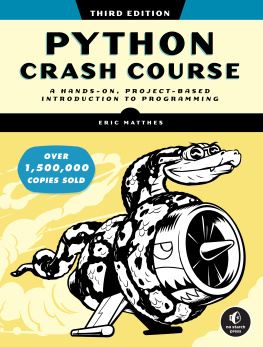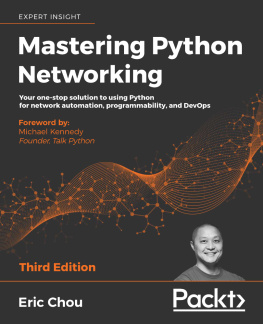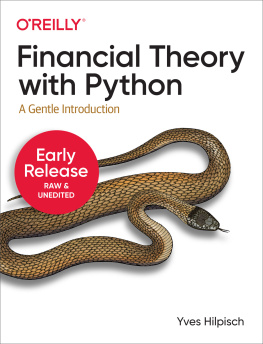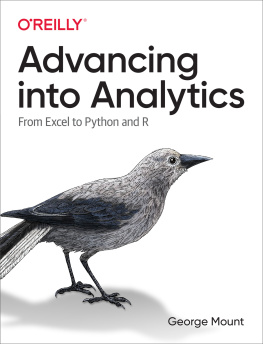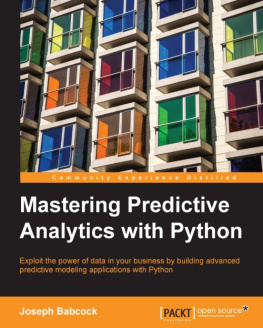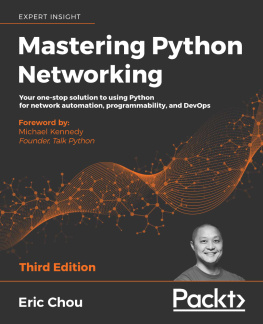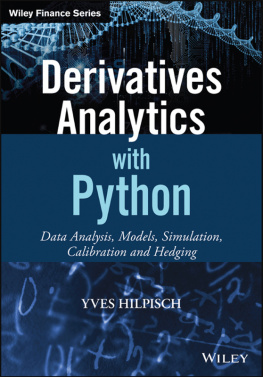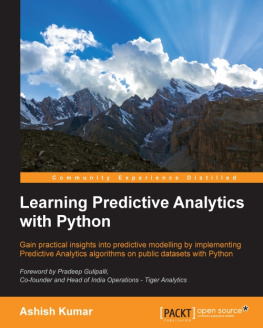Eric A. Eager - Football Analytics with Python & R. Early Release
Here you can read online Eric A. Eager - Football Analytics with Python & R. Early Release full text of the book (entire story) in english for free. Download pdf and epub, get meaning, cover and reviews about this ebook. year: 2023, publisher: OReilly Media, Inc., genre: Home and family. Description of the work, (preface) as well as reviews are available. Best literature library LitArk.com created for fans of good reading and offers a wide selection of genres:
Romance novel
Science fiction
Adventure
Detective
Science
History
Home and family
Prose
Art
Politics
Computer
Non-fiction
Religion
Business
Children
Humor
Choose a favorite category and find really read worthwhile books. Enjoy immersion in the world of imagination, feel the emotions of the characters or learn something new for yourself, make an fascinating discovery.
- Book:Football Analytics with Python & R. Early Release
- Author:
- Publisher:OReilly Media, Inc.
- Genre:
- Year:2023
- Rating:3 / 5
- Favourites:Add to favourites
- Your mark:
- 60
- 1
- 2
- 3
- 4
- 5
Football Analytics with Python & R. Early Release: summary, description and annotation
We offer to read an annotation, description, summary or preface (depends on what the author of the book "Football Analytics with Python & R. Early Release" wrote himself). If you haven't found the necessary information about the book — write in the comments, we will try to find it.
Football Analytics with Python & R. Early Release — read online for free the complete book (whole text) full work
Below is the text of the book, divided by pages. System saving the place of the last page read, allows you to conveniently read the book "Football Analytics with Python & R. Early Release" online for free, without having to search again every time where you left off. Put a bookmark, and you can go to the page where you finished reading at any time.
Font size:
Interval:
Bookmark:

by Eric A. Eager and Richard A. Erickson
Copyright 2022 Eric A. Eager and Richard A. Erickson. All rights reserved.
Printed in the United States of America.
Published by OReilly Media, Inc. , 1005 Gravenstein Highway North, Sebastopol, CA 95472.
OReilly books may be purchased for educational, business, or sales promotional use. Online editions are also available for most titles (https://oreilly.com). For more information, contact our corporate/institutional sales department: 800-998-9938 or corporate@oreilly.com .
- Acquisitions Editor: Michelle Smith
- Development Editor: Corbin Collins
- Production Editor: Clare Jensen
- Interior Designer: David Futato
- Cover Designer: Karen Montgomery
- Illustrator: Kate Dullea
- October 2023: First Edition
- 2022-07-21: First Release
See https://oreilly.com/catalog/errata.csp?isbn=9781492099628 for release details.
The OReilly logo is a registered trademark of OReilly Media, Inc. Football Analytics with Python and R, the cover image, and related trade dress are trademarks of OReilly Media, Inc.
The views expressed in this work are those of the author(s), and do not represent the publishers views. While the publisher and the author(s) have used good faith efforts to ensure that the information and instructions contained in this work are accurate, the publisher and the author(s) disclaim all responsibility for errors or omissions, including without limitation responsibility for damages resulting from the use of or reliance on this work. Use of the information and instructions contained in this work is at your own risk. If any code samples or other technology this work contains or describes is subject to open source licenses or the intellectual property rights of others, it is your responsibility to ensure that your use thereof complies with such licenses and/or rights.
978-1-492-09956-7
With Early Release ebooks, you get books in their earliest formthe authors raw and unedited content as they writeso you can take advantage of these technologies long before the official release of these titles.
This will be the 1st chapter of the final book. Please note that the GitHub repo will be made active later on.
If you have comments about how we might improve the content and/or examples in this book, or if you notice missing material within this chapter, please reach out to the editor at .
Football analytics, and more broadly, data science, require a broad setof tools. Successful practitioners in these fields require anunderstanding of these tools. Statistical programming languages are abackbone of our data science toolbox. These programs allow us to cleanour datasets, conduct our analyses, and readily reuse our methods.Although many people commonly use spreadsheets (such as Microsoft Excelor Google Sheets) for data cleaning and analysis, we find spreadsheetsdo not scale well. For example, when one has to work with large datasetslike tracking data, which can contain thousands of rows of data perplay, spreadsheets simply are not up to the task. Programming languagesalso allow for easy reuse because copy and pasting formulas inspreadsheets can be tedious and error prone. Lastly, spreadsheets allowundocumented errors. For example, spreadsheets do not having a method tocatch a copying and pasting mistake.. Furthermore, modern data sciencetools allow code, data, and results to be blended together ineasy-to-use interfaces. Common languages include Python, R, Julia,Matlab, and SAS. Additional languages continue to appear as computerscience continues to advance.
As practitioners of data science, we use R and Python daily for ourwork, which has collectively spanned the space of applied mathematics,applied statistics, theoretical ecology and, of course, footballanalytics. Of the languages listed previously, Python and R offer thebenefit of larger user bases (and hence likely contain the tools andmodels we need). Both R and Python (as well as Julia) are open source.Open source means two types of freedom. First, anybody can access allthe code in the language, and this freedom is sometimes called librefreedom (think free like in free speech). This allows volunteers tohelp improve the languages, such ensuring that users can debug the codeand extend the languages through add-on packages. Open source alsooffers the benefit of free to use for users, sometimes called gratisfreedom (think free like in free beer). Hence, users do not need topay thousands of dollars annually in licensing fees. We were initiallytrained in R, but have learned Python over the course of our jobs.Either language is well suited for football analytics (and sportsanalytics in general).
We encourage you to pick one language for the book and learn thatlanguage well. Should you need to learn a second programming language,it is easier if you understand the programming concepts behind a firstlanguage well. Then, you can relate the concepts back to yourunderstanding of your original computer language. Although many peoplepick favorite languages and sometimes have arguments with each otherover which coding language is better (similar to Coke versus Pepsi orFord versus General Motors), we have seen both R and Python used inproduction and also used with large data and complex models. Forexample, we have used R with 100 GB files on servers with sufficientmemory. Both of us began our careers coding almost exclusively in R, buthave learned to use Python when the situation has called for it.
When picking a language, we suggest you use what your friends use.They can then help you debug and troubleshoot.If you still need help deciding, open up both languages and play around for a little bit.See which one you like better.Personally, the authors like R when working with data, because of Rs data manipulation tools, and Python when building and deploying new models because of Pythons cleaner syntax.
The Dutch computer scientist, Guido van Rossum, created Python as aprogramming language in 1991. The language is often considered clean andeasy to understand because the code uses white space for formatting andgrouping (for example, rather than using {} like R, Python uses blankspace to group code). The language allows extensions through packages,although multiple package managers exist. Python can be used foreverything from video game development to web-page hosting. The languageis well designed with respect to computer science concepts, but can alsobe used as an interactive tool to explore data or scripting statisticalmethods.
Pythons numerical tools emerged as replacements for other languages.NumPy emerged as a replacement for MatLabs matrix tools and othernumerical methods. Matplotlib emerged as a plotting library inspired byMatLabs plotting style and syntax. Pandas emerged as data frame tools,inspired by Rs data.frame objects. In contrast to a matrix, whichtypically only allows values of one type (such as only allowing numbersor characters), data frames allow columns to be different data types(similar to a spreadsheet with columns of text and columns of numbers).We use Miniconda for this book because it allows for more than Python tobe installed and managed. For example, Miniconda can also be used toinstall R and R packages. Miniconda may be installed from theprojectspage.
Font size:
Interval:
Bookmark:
Similar books «Football Analytics with Python & R. Early Release»
Look at similar books to Football Analytics with Python & R. Early Release. We have selected literature similar in name and meaning in the hope of providing readers with more options to find new, interesting, not yet read works.
Discussion, reviews of the book Football Analytics with Python & R. Early Release and just readers' own opinions. Leave your comments, write what you think about the work, its meaning or the main characters. Specify what exactly you liked and what you didn't like, and why you think so.



